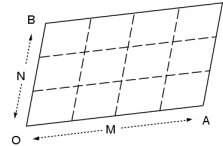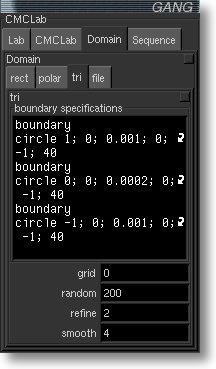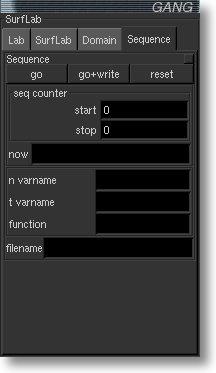Lab Guide
In the Lab notebook widget you'll find:- Controls - Start and stop computations of a surface
- Domain - Setting the domain specifications for a surface
- Sequence - compute a sequence of surfaces
Controls Panel
The Control Panel
Use the Control panel to start a computation of a surface.
The buttons:- After setting the potential functions and the domain (see below), press the go button to compute the surface.
- The stop button cancels a computation in progress.
- The progress bar shows percent progress of the computation.
Domain Panel
The domain of a surface can be specified in four ways:Rectangular Grid
The Rectangular Domain Panel
In rectangular mode, specify a parallelogram with corners O, A and B represented by complex numbers. The mesh is defined by dividing the sides OA and OB into M and N parts respectively, generating a parallelogram mesh.
Rectangular Domain
Polar Grid
The Polar Domain Panel
Use the polar mode to specify a sector of an annulus with center O a complex number, real radii R1 and R2, real angles spanning A1 to A2. The mesh is defined by division of the radial segment into M parts and the angle into N parts.
Polar Domain
Delaunay Triangulation
The Triangulated Domain Panel
A triangulate domain is specified by describing a boundary in the plane, together with mesh parameters. The internal triangulator then computes a triangulation of the planar domain inside the boundary.
The planar domain to be triangulated is specified by (1) a list of Jordan curves in the plane which do not mutually intersect. These curve cut the plane into regions. (2) A subset of these regions is designated to be removed from the planar domain by specifying a point in each region.
The boundary is specified as a list of elements of the following format
Type type ... type"Type" is one of Loop, Line, Point, Hole
- Loop means that the points next specified form a loop.
- Loop means that the points next specified form a line.
- Loop means that the points next specified form a set of points.
- circle x; y; r; a1; a2;
n
This specifies the oriented arc of a circle with center (x, y) and radius r, spanning the angle from a1 to a2. The angle units are chosen so that an angle value of 1 is 2 pi radians. The arc is divided into n equal subarcs by points along it. - line x1; y1; x2; y2;
n
This specifies an oriented straight line segment starting at point (x1, y1) and ending at point (x2, y2), divided into n equal subsegments by points along it. - point x; y
This specifies an point with coordinates (x, y).
- refine - after triangulating, insert points at the midpoints of segments. Repeat for the whole triangulation n times.
- smooth - perform Laplacian smoothing on the whole triangulation n times. This replaces each vertex with the average of the vertices connected to it by edges. After smoothing, a triangulation loses the Delaunay property.
Triangulation File
Choose the "file" notebook page on the Domain Panel. Type the name of file specifying a domain. The file must be a surface readable by iSight, for example in VRML format, and its polygons must be triangles. The projection of the surface to its first two coordinates will be used as the domain.
The triangulator is experimental.
Sequence Panel
The Sequence Panel
With the Sequence panel you can make sequences of image files suitable for making animation files in formats such as MPEG or QuickTime.
The sequence panel is not yet fully implemented.
| Lab Guide | GANG |






